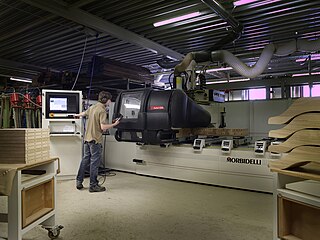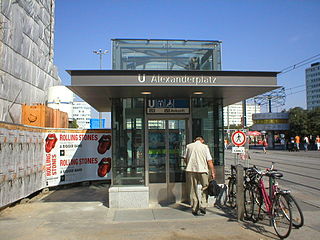Technology
The operator is placed in the space above the sliding door.
An electric motor, geared down to get a lower speed and a higher torque, drives a pulley at one end of a belt. The door is clamped to the belt. To open the door, the motor turns the pulley, which in turn turns the belt, which in turn drags the door. To close the door, the reverse occurs.
Historically, elevator doors were opened using simple harmonic motion by a set of mechanical linkages; the motor, geared down, would rotate linked arms, which in turn would drive the door.
An actuator is a component of a machine that produces force, torque, or displacement, usually in a controlled way, when an electrical, pneumatic or hydraulic input is supplied to it in a system. An actuator converts such an input signal into the required form of mechanical energy. It is a type of transducer. In simple terms, it is a "mover".

A continuously variable transmission (CVT) is an automated transmission that can change through a continuous range of gear ratios. This contrasts with other transmissions that provide a limited number of gear ratios in fixed steps. The flexibility of a CVT with suitable control may allow the engine to operate at a constant angular velocity while the vehicle moves at varying speeds.

In machining, numerical control, also called computer numerical control (CNC), is the automated control of tools by means of a computer. It is used to operate tools such as drills, lathes, mills, grinders, routers and 3D printers. CNC transforms a piece of material into a specified shape by following coded programmed instructions and without a manual operator directly controlling the machining operation.
A motor glider is a fixed-wing aircraft that can be flown with or without engine power. The FAI Gliding Commission Sporting Code definition is: a fixed-wing aerodyne equipped with a means of propulsion (MoP), capable of sustained soaring flight without thrust from the means of propulsion.

An automatic door, also known as an auto door, is a door that opens automatically, without the need for human intervention or usually upon sensing the approach of a person. A person can be detected by microwave pulses, infrared sensors, or pressure-sensing pads.

A garage door opener is a motorized device that opens and closes a garage door controlled by switches on the garage wall. Most also include a handheld radio remote control carried by the owner, which can be used to open and close the door from a short distance.

In machining, a metal lathe or metalworking lathe is a large class of lathes designed for precisely machining relatively hard materials. They were originally designed to machine metals; however, with the advent of plastics and other materials, and with their inherent versatility, they are used in a wide range of applications, and a broad range of materials. In machining jargon, where the larger context is already understood, they are usually simply called lathes, or else referred to by more-specific subtype names. These rigid machine tools remove material from a rotating workpiece via the movements of various cutting tools, such as tool bits and drill bits.

A motion detector is an electrical device that utilizes a sensor to detect nearby motion. Such a device is often integrated as a component of a system that automatically performs a task or alerts a user of motion in an area. They form a vital component of security, automated lighting control, home control, energy efficiency, and other useful systems.

A garage door is a large door on a garage that opens either manually or by an electric motor. Garage doors are frequently large enough to accommodate automobiles and other vehicles. The size of the garage doors varies. Small garage doors may be made in a single panel that tilts up and back across the garage ceiling. Larger doors are usually made in several jointed panels that roll up on tracks across the garage ceiling, or into a roll above the doorway. The operating mechanism is usually spring-loaded or counterbalanced to offset the weight of the door and reduce the human or motor effort required to operate the door. Less commonly, some garage doors slide or swing horizontally. Doors are made of wood, metal, or fiberglass, and may be insulated to prevent heat loss.
A swing-door operator is a device that operates a swing door for pedestrian use. It opens or helps open the door automatically, waits, then closes it.

A sliding door is a type of door which opens horizontally by sliding, usually parallel to a wall. Sliding doors can be mounted either on top of a track below or be suspended from a track above. Some types slide into a space in the parallel wall in the direction of travel, rather than the door sliding along the outside of the parallel wall. There are several types of sliding doors, such as pocket doors, sliding glass doors, center-opening doors, and bypass doors. Sliding doors are commonly used as shower doors, glass doors, screen doors, and wardrobe doors, and in vans.
The following outline is provided as an overview of and topical guide to automobiles:

A conveyor system is a common piece of mechanical handling equipment that moves materials from one location to another. Conveyors are especially useful in applications involving the transport of heavy or bulky materials. Conveyor systems allow quick and efficient transport for a wide variety of materials, which make them very popular in the material handling and packaging industries. They also have popular consumer applications, as they are often found in supermarkets and airports, constituting the final leg of item/ bag delivery to customers. Many kinds of conveying systems are available and are used according to the various needs of different industries. There are chain conveyors as well. Chain conveyors consist of enclosed tracks, I-Beam, towline, power & free, and hand pushed trolleys.

An electric gate is a type of gate that can be opened and closed using an electrically powered mechanism.

A collision avoidance system (CAS), also known as a pre-crash system, forward collision warning system (FCW), or collision mitigation system, is an advanced driver-assistance system designed to prevent or reduce the severity of a collision. In its basic form, a forward collision warning system monitors a vehicle's speed, the speed of the vehicle in front of it, and the distance between the vehicles, so that it can provide a warning to the driver if the vehicles get too close, potentially helping to avoid a crash. Various technologies and sensors that are used include radar (all-weather) and sometimes laser (LIDAR) and cameras to detect an imminent crash. GPS sensors can detect fixed dangers such as approaching stop signs through a location database. Pedestrian detection can also be a feature of these types of systems.

An elevator (North American English) or lift (British English) is a machine that vertically transports people or freight between levels. They are typically powered by electric motors that drive traction cables and counterweight systems such as a hoist, although some pump hydraulic fluid to raise a cylindrical piston like a jack.

Machine element or hardware refers to an elementary component of a machine. These elements consist of three basic types:
- structural components such as frame members, bearings, axles, splines, fasteners, seals, and lubricants,
- mechanisms that control movement in various ways such as gear trains, belt or chain drives, linkages, cam and follower systems, including brakes and clutches, and
- control components such as buttons, switches, indicators, sensors, actuators and computer controllers.

A motorcycle transmission is a transmission created specifically for motorcycle applications. They may also be found in use on other light vehicles such as motor tricycles and quadbikes, go-karts, offroad buggies, auto rickshaws, mowers, and other utility vehicles, microcars, and even some superlight racing cars.

The Raphael Mackeller Stores is a heritage-listed former store and now museum located at 4–6 Kendall Lane in the inner city Sydney suburb of The Rocks in the City of Sydney local government area of New South Wales, Australia. It was built from 1853 to 1854 for Joseph George Raphael. It is also known as The Rocks Toy Museum, Unwin's Coach House, Coach House, and The Coachhouse. The property is owned by Property NSW, an agency of the Government of New South Wales. It was added to the New South Wales State Heritage Register on 10 May 2002.















